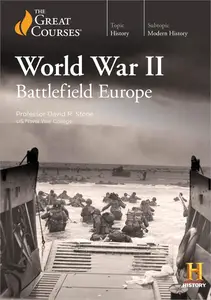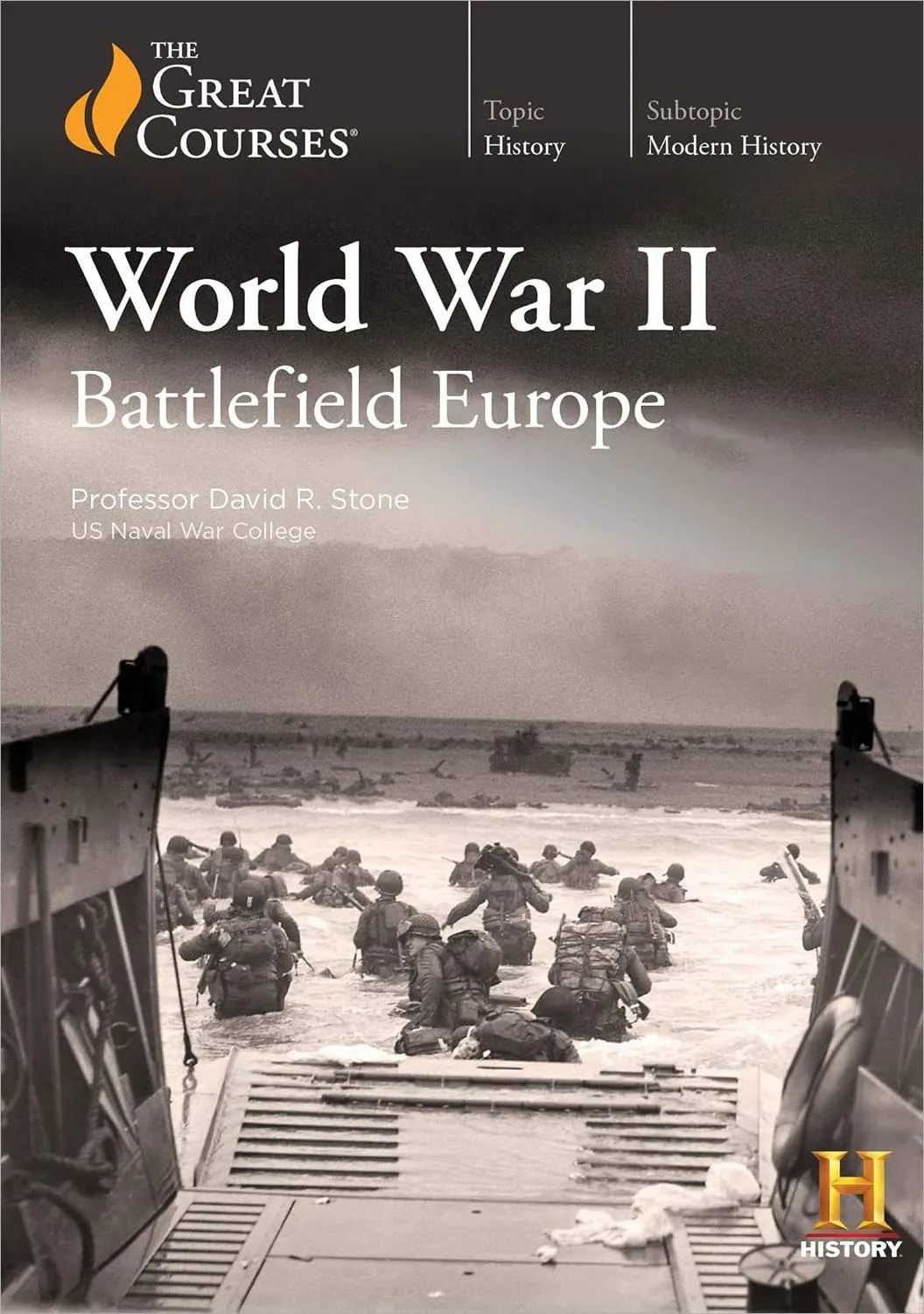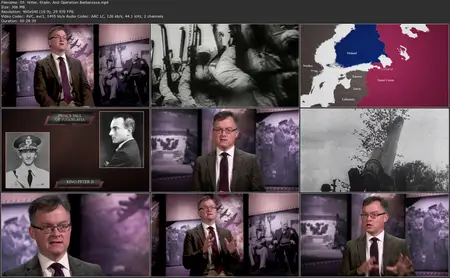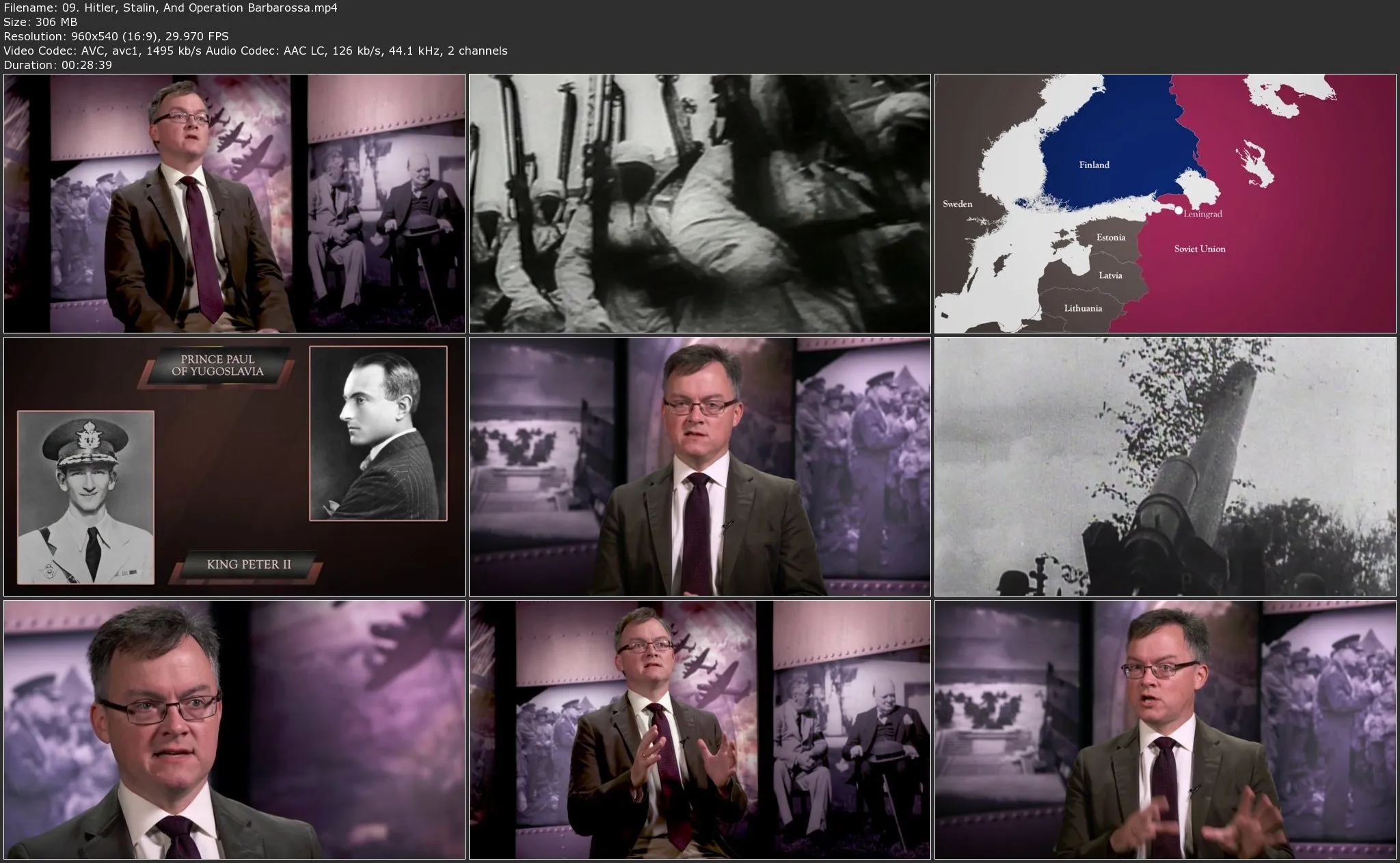TTC Video - World War II: Battlefield Europe
.MP4, AVC, 960x540, 30 fps | English, AAC, 2 Ch | 11h 21m | 7.2 GB
Lecturer: David R. Stone, PhD Professor, U.S. Naval War College | Course No. 8762
.MP4, AVC, 960x540, 30 fps | English, AAC, 2 Ch | 11h 21m | 7.2 GB
Lecturer: David R. Stone, PhD Professor, U.S. Naval War College | Course No. 8762
In more ways that you can imagine, today’s geopolitical climate is a product of World War II. The United States, France, Germany, Russia, and Britain—all of these world powers and their sense of place in the 21st century were profoundly shaped by the most savage, sweeping war in human history.
The topic of World War II’s European Theater is so vast that it requires an expert historian to make sense of it all. How was the war in Europe fought over the course of seven long, arduous years? What led to Germany’s early sustained gains, and what eventually stymied its advances? Why did the war in Europe unfold the way it did, and what socio-economic factors led to Germany’s unconditional surrender after millions of lives were lost?
For award-winning Professor David R. Stone of the U.S. Naval War College, it all boils down to a matter of strategy. Strategic choices—political ones, economic ones, military ones—are the organizing principles that can help any of us make sense of the war in Europe. “Political and military leaders had to make hard decisions,” Professor Stone says. “We can learn a lot by looking at those choices.”
World War II: Battlefield Europe is Professor Stone’s expansive 24-lecture exploration of the 20th century’s defining conflict. Designed in partnership with HISTORY® and using a distinctly European perspective (in which the United States is a supporting player instead of a main character), this course provides a fresh lens through which to study the European Theater’s major battles, larger-than-life personalities, twists of fate, and tales of intrigue. You’ll uncover the strategic decisions behind U-boat assaults, urban bombing campaigns, Operation Barbarossa, D-Day, the Battle of the Bulge, the invasion of Italy, the French resistance, the fall of Berlin, V-2 rockets, and so much more. By the end of the last lecture, you’ll better understand why the war in Europe unfolded the way it did—and why its legacy resonates for all players down to this very day.
While World War II had two theaters of combat, the European Theater of 1939 to 1945 was the violent core of this global conflict between the forces of totalitarianism and those of freedom. It was on the European continent where Nazi Germany began its project of expansion and murder. It was on the European continent where Allied and Axis forces clashed at Stalingrad, el-Alamein, Anzio, and Normandy. And it was on the European continent where Nazi Germany was ultimately defeated and the stage was set for the Cold War that would consume the post-war world.
Strategic Looks at Epic Battles
In developing World War II: Battlefield Europe, Professor Stone came up with the conservative estimate that there are over 300,000 books and 30,000 scholarly articles dealing with World War II. It’s a conflict that’s so enormous, no one can master it all at once.
That’s why these lectures dig deep into the European Theater of war, and specifically the real-life military and political strategies behind some of the war’s most definitive battles.
Provocative Questions, Illuminating Answers
A large part of military strategy isn’t just executing plans, but learning lessons from both victory and defeat. Professor Stone contextualizes the defining moments of World War II by illustrating what the various armies on the European continent took away from their clashes.
For example, after the Soviet victory at the Battle of Moscow in 1941, Hitler, who’d always had trouble taking the advice of military professionals, fired his army commander-in-chief and made himself the German army’s supreme commander. Stalin, on the other hand, came to the right conclusion: Civilian leaders should trust military professionals to make the decisions they’re not competent to make.
Throughout World War II: Battlefield Europe, you’ll get the opportunity to explore challenging and provocative questions about why the European Theater turned out the way it did. Using military and historical expertise, Professor Stone uncovers answers to these and other long-simmering issues.
A Definitive Learning Experience
World War II: Battlefield Europe puts you in the heat of battle alongside an award-winning military historian. In his role as Professor of Strategy and Policy at the U.S. Naval War College, Professor Stone is adept at helping laypeople understand the secret mechanics of warfare: how decisions are made, how forces move, and how battles are won (and lost).
In addition to Professor Stone’s brilliant scholarship, these lectures are powered by HISTORY’s extensive, high-quality coverage of World War II. Strategic maps, photographs, film footage, and illustrated recreations make this course a definitive learning experience unlike anything The Great Courses has ever before produced.
“Informed citizens need to understand their history,” says Professor Stone. With its profound effect on the world for decades following the conflict, World War II is a central part of that history.
For award-winning Professor David R. Stone of the U.S. Naval War College, it all boils down to a matter of strategy. Strategic choices—political ones, economic ones, military ones—are the organizing principles that can help any of us make sense of the war in Europe. “Political and military leaders had to make hard decisions,” Professor Stone says. “We can learn a lot by looking at those choices.”
World War II: Battlefield Europe is Professor Stone’s expansive 24-lecture exploration of the 20th century’s defining conflict. Designed in partnership with HISTORY® and using a distinctly European perspective (in which the United States is a supporting player instead of a main character), this course provides a fresh lens through which to study the European Theater’s major battles, larger-than-life personalities, twists of fate, and tales of intrigue. You’ll uncover the strategic decisions behind U-boat assaults, urban bombing campaigns, Operation Barbarossa, D-Day, the Battle of the Bulge, the invasion of Italy, the French resistance, the fall of Berlin, V-2 rockets, and so much more. By the end of the last lecture, you’ll better understand why the war in Europe unfolded the way it did—and why its legacy resonates for all players down to this very day.
While World War II had two theaters of combat, the European Theater of 1939 to 1945 was the violent core of this global conflict between the forces of totalitarianism and those of freedom. It was on the European continent where Nazi Germany began its project of expansion and murder. It was on the European continent where Allied and Axis forces clashed at Stalingrad, el-Alamein, Anzio, and Normandy. And it was on the European continent where Nazi Germany was ultimately defeated and the stage was set for the Cold War that would consume the post-war world.
Strategic Looks at Epic Battles
In developing World War II: Battlefield Europe, Professor Stone came up with the conservative estimate that there are over 300,000 books and 30,000 scholarly articles dealing with World War II. It’s a conflict that’s so enormous, no one can master it all at once.
That’s why these lectures dig deep into the European Theater of war, and specifically the real-life military and political strategies behind some of the war’s most definitive battles.
- The Battle of Britain: From the second half of 1940 through most of 1941, the British Royal Air Force and its German equivalent, the Luftwaffe, waged a desperate struggle for control of the skies over England. Dubbed the Battle of Britain by Winston Churchill, the fight raises a number of important strategic questions, including whether Germany’s shift from attacking the RAF to bombing British cities (which appealed to Hitler’s desire to make Britain suffer) might have cost the Nazis their chance at victory.
- The Battle of Stalingrad: While Stalingrad (known today as the city of Volgograd) was one of World War II’s most decisive battles, the regional industrial center in the southeastern section of European Russia wasn’t important in itself. But the city sits where the Volga River takes a big swing westward as it flows south into the Caspian Sea, which meant the Germans couldn’t let the city remain in Soviet hands as it was too big a threat to the flank of their push to grab the oil fields around the Azerbaijani city of Baku.
- The D-Day Invasion: Training for war is, naturally, serious business. It was even more so for the Allied invasion of Europe. Two months before the landing at Utah Beach, 750 American soldiers died at Slapton Sands in southwest England during a training exercise, which was attacked by the Germans. Because a number of the dead Americans had been briefed on the D-Day invasion plans, their bodies had to be recovered to ensure they hadn’t been captured and the plan wasn’t compromised.
- The Battle of the Atlantic: What finally turned the tide in favor of Allied submarines and sea forces? Much of the eventual victory was due to technological developments, including better sonar and radar with which to find enemy subs; a forward-firing battery of depth charges known as “the hedgehog”; and a torpedo known as “Fido” (deliberately called a mine to be misleading to the enemy), which could track submerged submarines and, more important, could be dropped from Allied aircraft.
Provocative Questions, Illuminating Answers
A large part of military strategy isn’t just executing plans, but learning lessons from both victory and defeat. Professor Stone contextualizes the defining moments of World War II by illustrating what the various armies on the European continent took away from their clashes.
For example, after the Soviet victory at the Battle of Moscow in 1941, Hitler, who’d always had trouble taking the advice of military professionals, fired his army commander-in-chief and made himself the German army’s supreme commander. Stalin, on the other hand, came to the right conclusion: Civilian leaders should trust military professionals to make the decisions they’re not competent to make.
Throughout World War II: Battlefield Europe, you’ll get the opportunity to explore challenging and provocative questions about why the European Theater turned out the way it did. Using military and historical expertise, Professor Stone uncovers answers to these and other long-simmering issues.
- How did European anti-Semitism evolve from a belief system rooted in religion to one rooted in race and biology?
- What kept other European powers from re-engaging Germany and stopping Hitler long before he grew too powerful?
- Why did Hitler break his non-aggression pact with the Soviet Union—and what made him think such a radical move would work?
- Could the Allied forces have done anything to stop, or even just to slow down, the horrors of the Holocaust?
- Why, with Berlin under siege and German defeat inevitable, did Hitler keep fighting—and why did his army let him do it?
A Definitive Learning Experience
World War II: Battlefield Europe puts you in the heat of battle alongside an award-winning military historian. In his role as Professor of Strategy and Policy at the U.S. Naval War College, Professor Stone is adept at helping laypeople understand the secret mechanics of warfare: how decisions are made, how forces move, and how battles are won (and lost).
In addition to Professor Stone’s brilliant scholarship, these lectures are powered by HISTORY’s extensive, high-quality coverage of World War II. Strategic maps, photographs, film footage, and illustrated recreations make this course a definitive learning experience unlike anything The Great Courses has ever before produced.
“Informed citizens need to understand their history,” says Professor Stone. With its profound effect on the world for decades following the conflict, World War II is a central part of that history.





